Trekking tour - 15 days/ 12 days trekking
About UTTARAKHAND
Uttarakhand is a state blessed with an enormous diversity of cultures and landscapes. Just like Himachal Pradesh, Sikkim, Bhutan and Arunachal Pradesh, it spans the whole altitudinal range from steamy jungle where tigers and wild elephants roam to some of the highest peaks of the Himalayas. One of them is Nanda Devi (7816 m, 25,636 ft), the highest mountain that lies fully in India.
TREKKERS’ PARADISEThe higher reaches of the Uttarakhand Himalayas are a mecca for trekkers. You can follow the herders up to the high bughyals (alpine meadows) and trek up to passes that in the old days gave access to Tibet. They reward you with some of the best glacial vistas in the Himalayas. Although the number of Indian trekkers is increasing, these areas still don’t get that many visitors as the much more known treks of Ladakh and Himachal Pradesh.
Read more…Read less
Wildlife enthusiasts find a treasure trove of biodiversity here, partly protected in national parks and wildlife reserves throughout the state. Most notably, Jim Corbett National Park and Nanda Devi & Valley of Flowers National Park. Jim Corbett National Park is named after A famous British hunter-turned-conservationist. It is well known and popular as it is one of the tiger parks in India that is easiest to reach from Delhi. Apart from being home to a wide array of mammals, birds and plant life, it has very appealing landscapes and a well-laid out infrastructure of jeep trails. Nanda Devi & Valley of Flowers National Parks are two formerly separated but now joined protected areas lying almost completely at or higher than 3500m (11.500 ft). They can be explored only on foot.
HINDU PILGRIMAGETo Hindus – who make up 83% of the state’s population – the higher reaches of Uttarakhand are known as Dev Bhoomi – the abode of the gods. This is not just folklore, as present day Hindu culture finds many of its roots in this area. It is believed that the sage Vyasa scripted the Hindu epic Mahabharata here. In the Middle Ages, the Hindu kingdoms of Garwhal and Kumaon made up the western and eastern part of the present day state, respectively.
Millions flock every year to the many pilgrim sites that the state harbors. Easily accessible places like Rishikesh, Haridwar are not only popular with Hindu pilgrims but also host numerous ashrams and yoga schools that cater mainly to foreign visitors. Much higher up, you can witness die-hard Hindu pilgrims and saddhus dipping themselves in ice-cold waters where Mother Ganga (Ganges) emerges from the mouth of a glacier.
BREATHTAKING VIEWS, COZY RETREATSTraveling by car, you may experience Uttarakhand as a never-ending series of curves and switchbacks, but after each of these bends new views and sights await you. The mountains are covered in forests and green fields and especially in the winter months you get breathtaking views of the snow-clad Himalayas on the border with Tibet (China). Uttarakhand counts numerous so-called hill stations, towns situated at medium elevation levels that have been welcoming tourist since the British era. These hill stations are popular with domestic tourists, but have a lot to offer to ‘foreigners’ as well. In and around them, you can find (with some effort) hidden lodges, boutique hotels and family-run retreats with a high degree of the ‘Hotel California factor’: you can check in any time, but you may never want to leave.
Region
Uttarakhand
(India)
Best Time
Mid-May/ June &
Sept./ Mid-Oct.
No. Of Days
15 days, 12 days trek
Trip Character
Trekking tour
Sleeping Altitude
290 - 5150 m
Trek Character
Camping trek
Level: 3
Price
INR XXX/ $ XXX
ABOUT THIS TOUR
The Panpatia Col (or Pass) is considered one of the most challenging – and least done – treks of medium length in Uttarakhand. This is only for experienced trekkers, with knowledge of using ice axes, crampons and roping up procedures. It crosses a pass at 5260m,
Following a Ganges tributary, the Alaknanda River, to its upper reaches, you’ll reach Badrinath, one of the four most important Hindu pilgrim places in the Uttarakhand Himalayas (3100m). Here, you’ll follow in the footsteps of early explorers like Meade, Shipton, Tilman, Martin Moran and Harish Kaparia. They were all drawn by the lore that a priest from Badrinath would trek to Kedarnath in a day. One look on the map will tell you that this can only be done by traversing a very large glacier pass.
This pass, the Panpatia Col, hides its approach within crevassed snowfields, rocky moraines and a large glacier flanked by massive ice falls. As a result, most early expeditions failed to find the way through.
The pass is reached after traversing the 7km long Panpatia glaciar/snowfield. Once on the pass, you are rewarded with spectacular views of nearby peaks such as Nilkantha, Balakun, Hathi Parvat, and Dhauliganga Peaks. Descending, XXX.
YOUR custom-made TRIP
The tour described here, as well as the other ones on our website, are mainly meant as suggestions. We would be happy to offer you a travel proposal that fully meets your personal demands and expectations. That means that you choose where you want to go, what level of accommodation and type of transport you want and what activities you prefer.
Please let yourself be inspired by this and other trips on our website and then drop us a line (or call us) to explain your travel wishes. We will be happy to help you put together the perfect trip. You can reach us over e-mail, Messenger, Whatsapp or mobile phone.
EXTENSIONS & VARIATIONS
Apart from the tour as described here, you could consider the following add-ons and changes:
- On all tours In India we can organise one or two days sight-seeing in Delhi, either at the beginning or the end of the tour. You would be taken to Connaught Place, the center of New Delhi, the bustling beehive of Old Delhi, the Red Fort, Qutub Minar (an old minaret), The Akshardam Temple and more if you like.
- For those who want to see more of the Indian plains we can organise a one or two-day trip to Agra (site fo the Taj Mahal) or a three to five-day Golden Circle tour, taking in Delhi, Jaipur and Agra.
- Include another short trek on which you walk up to the source of the Ganges at Gaumukh near Gangotri. This can be done at the beginning or end of this tour. It adds six days in total to the tour.
- If trekking is not your cup of tea we can show you Uttarakhand and some of the beautiful high pilgrim places by car and by doing less strenuous day walks only.
ITINERARY
-
.fa-info {color: #1146a9;}.fa-info:hover {color: #387dff;}Day 01: Delhi - Haridwar (91,3 km/ XXX h)
Early morning transfer to the railway station where you board the Shatabdi Express to Haridwar. On arrival our guide and driver will welcome you and take you to your hotel. In the evening you can witness an aarti ceremony at the ghats (banks) of the Ganges River. Overnight in or near Haridwar. Altitude 215 → 290m. -
Day 02: Haridwar - Joshimath (>220 km/ 9 h)
Today, you'll follow the magnificent Alaknanda River to the important pilgrim place Joshimath. You'll pass the two prayags (confluences) of Dev Prayag and Rudraprayag. Overnight in Joshimath. Altitude 290 → 1820m. -
Day 03: Joshimath - Badrinath - Khirao (2 h drive, 3 km/ 1 h walking)
Another 2 hours hours of driving will take you past the important Hindu pilgrimage place of Badrinath, and over a smaller road to Hanuman Chatti. Here, we cross a footbridge over the Yamuna River and walk up to the small village of Khirao. Overnight in camp. Altitude 1875 → 2700m. -
Day 04: Khirao - Shepherd Camp (3 h walking)
From the village, a steep climb brings you up to the treeline and today's campsite in an open meadow. Altitude 2700 → 3500m. -
Day 05: Shepherd Camp - Panpatia Glacier (3-4 h)
Another 400m of climbing brings you to glacier camp, situated just 10 mins walk from the glacier snout. Altitude 3500 → 3900m. -
Day 06: Gacier Snout - Moraine Camp (8 km/ 3 h)
This is a relatively long day of gradual height gain. The never-ending moraine tends to get a bit monotonous but it’s a joy to weave across patches of snow to ease progress and add variety to the walk. There are magnificent peaks all around. Neelkanth and Parvati loom large on one side and a heavily crevassed glacier drops almost vertically to the other. Here you can catch your first glimpse of Chaukhamba. Altitude 3900 → 4300m. -
Day 07: At Moraine Camp
A day to relax and acclimatise, read, relax, or take a short walk near camp, or try and spot some wildlife. Overnight moraine camp. Altitude 3460 → 4000 → 3480m. -
Day 08: Moraine Camp - Parvati Col Basecamp (XXX km/ XXX h)
Trek to the base of Parvati Col. It’s a short but steep walk that brings you closer to the Panpatia snow field. The campsite is just below the Parvati Col. Altitude 4300 → 4600. -
Day 09: Parvati Col Basecamp - Panpatia Snow Field (XXX km, XXX h)
A steep climb brings you to the edge of the terrace from where the only way up is through a steep snow and rock gully. We will fix ropes to negotiate this passage and enter the domain of pure snow. A series of gentle humps gives way to the Parvati Col and the Panpatia snowfield—a huge plateau of snow ringed by lofty peaks. Chaukhamba rises in all its glory and, with some luck, you may also catch a view of Nanda Devi. Altitude 4600 → 5150m. -
Day 10: Panpatia Snow Field - Sujal Sarovar (XXXkm, XXX h)
The trail traverses the length of the Panpatia snowfield. Although it is a long traverse, there is negligible ascent. A short climb at the end brings you to Panpatia Col, beyond which is a vertigo-inducing descent that leads to Sujal Sarovar, the campsite. Altitude 5150 → 4700m. -
Day 11: Sujal Sarovar - Kachni (XXXkm, XXX h)
Trek to Kanchni Tal. A few metres above Sujal Sarovar is a small pass from where it is a steep descent through snowy slopes and boulder zones to Kanchni. Beyond the small Maindgalla tal is another traverse through the boulders that leads to Kanchni. The meadow overlooks the Madhmaheshwar Ganga. Altitude 4700 → 4150m. -
Day 12: Kachni - Nanu Chatti (XXXkm, XXX h)
Trek to Nanu Chatti. It takes about 3-4 hours to get to Madhmaheshwar temple beyond oak forests. From here, a paved trail rolls all the way to the roadhead at Ransi. It’s a leisurely walk through a forest to camp at Nanu Chatti, a small settlement of summer homes for people from Gaundhar village. Altitude 4150 → 3250. -
Day 13: Buffer day
We have a rest / contingency day to allow for bad weather and to have some flexibility in the itinerary. Overnight Camp. Altitude 3250m. -
Day 14: Nanu Chatti – Ransi – Rudraprayag (XXXkm, XXX h walking, 62km/ 2 h drivel)
Easy walk down to Ransi on the Madhmaheshwar temple trail, and onward drive to Rudraprayag. Overnight in hotel. Altitude 3250 → 690m. -
Day 15: Rudraprayag - Haridwar - Delhi 162km, 5 h drive, 4-6 h train ride)
The car takes you down to Haridwar, where you board the train to Delhi. There are many trains going. In case you have requested us to arrange accommodation in Delhi, our drive will await you at the railway station. Also, we can arrange sight seeing in Delhi or a visit to the Taj Mahal in Agra. Altitude 690 → 415 → 215m.
HIGHLIGHTS OF THIS TOUR
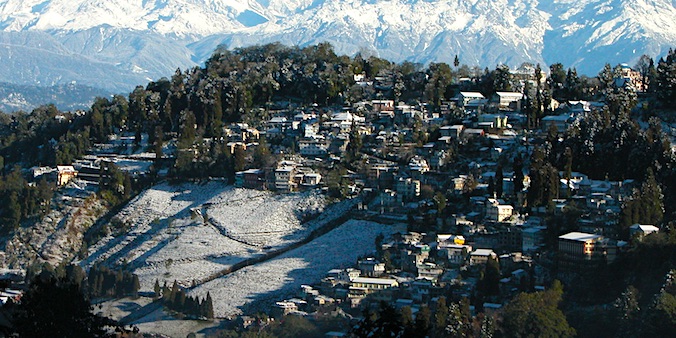
HARIDWAR and RISHIKESH
JOSHIMATH
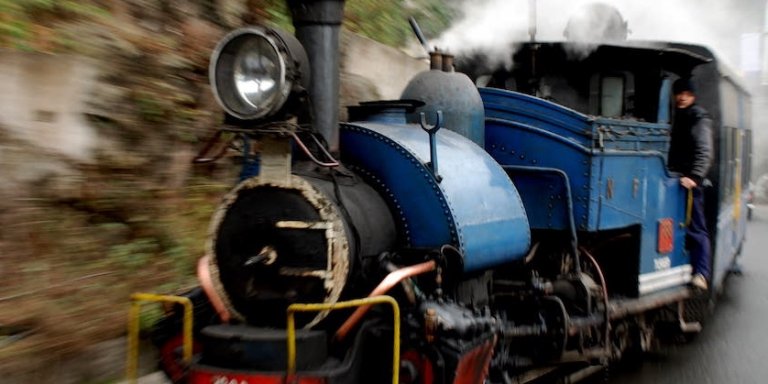

BADRINATH
If there is one legacy of the Brits in India it is tea. Tea estates, tea processing and exporting, and tea drinking. It was long believed that wild tea, Camelia sinensis, only grew in China, but this small woody brush was ‘rediscovered’ by the British in the early 19th century in the jungle of Assam. Camelia sinensis var. assamica had long been used by indigenous people. Large tracts of land were converted into tea gardens and these days Darjeeling (and Assam) tea are known worldwide. There are two kinds of preparation. The black tea that is being dunked in water that just has been boiled is called orthodox. In Indian households and tea stalls the tea is generally boiled for some time with milk and sugar, and sometimes spices. This is called CTC tea. The two kinds of tea require different factory handling, but both have the same Camelia leaves as the starting point.
HOLY HIMALAYAN LAKES
If we were to pick one trek that is, at best, moderately strenuous while offering superb views of the Himalayan giants, it is the Singalila Ridge Trek. On this trek you climb through well-protected subtropical forests teeming with butterflies, birdlife and some rare species like the red panda up to the montane zone of fir and Rhododendron. From late April to May exuberantly blooming rhododendrons and magnolias set the hill sides on fire. Emerging at the alpine meadows of Sandakphu, you’ll be treated to breathtaking views of the Himalayan range. Especially during autumn (October – December), when you can expect clear skies, you can see five summits higher than 8000m within one sweeping view, amongst them Everest, Kangchenjunga, Makalu and Lhotse.
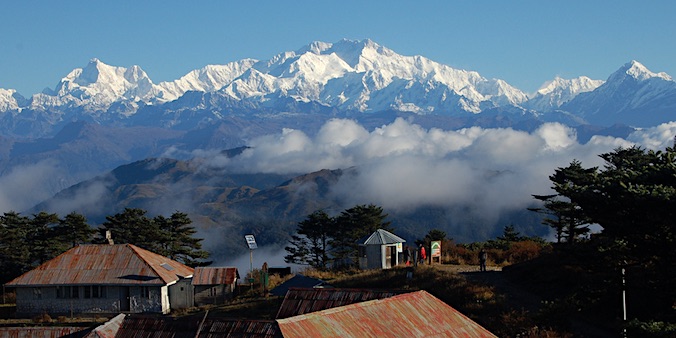
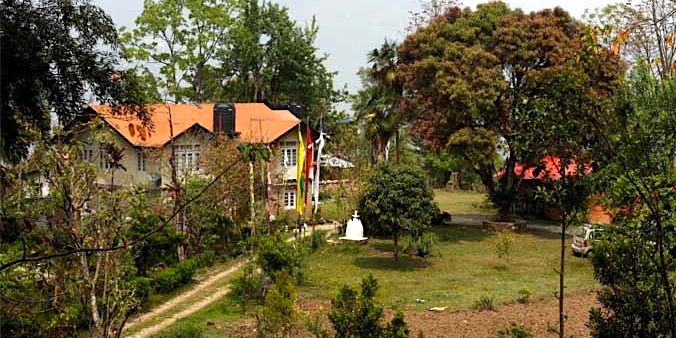
VALLEY of FLOWERS
KUARI PASS
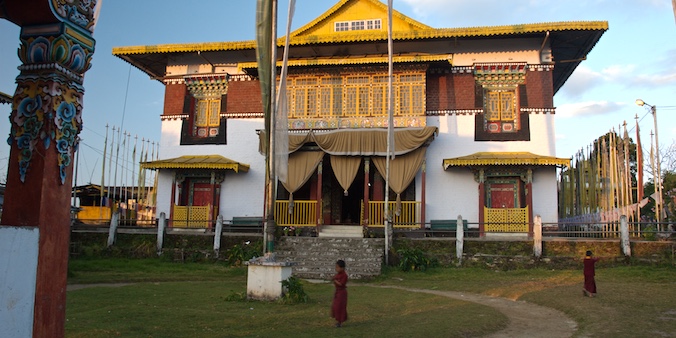
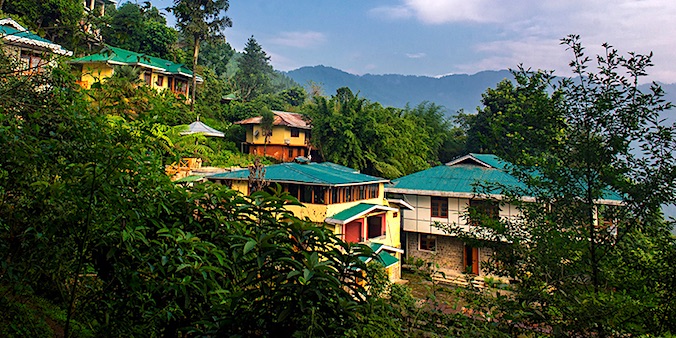
PANA and JHANGI
Teentaley Eco Resort is not a hotel but, as they say “an organic experience of the real, rural Sikkim.” Here, you stay in cozy bamboo cottages amidst a sprawling landscape garden, with a farmhouse and a private forest where you can go bird watching without leaving the premises. The food is home-grown, organic of course, and dinners are accompanied with the typical Sikkimese tongba – bamboo containers filled with millet beer. As the location, in Rumtek, is close to Gangtok, you can stay here, sleeping in the quiet of the mountains and waking to the birds’ songs, while visiting Sikkim’s capital during the day.
RAFTING on the GANGES
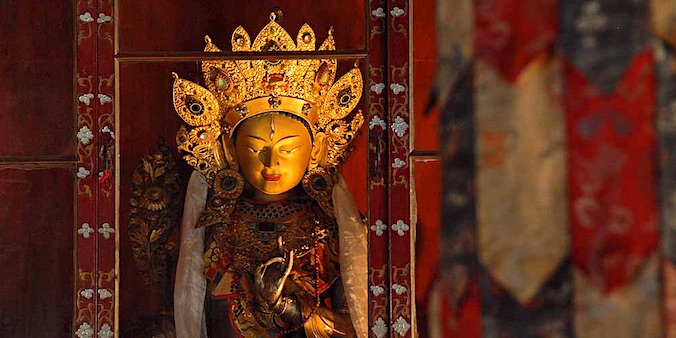
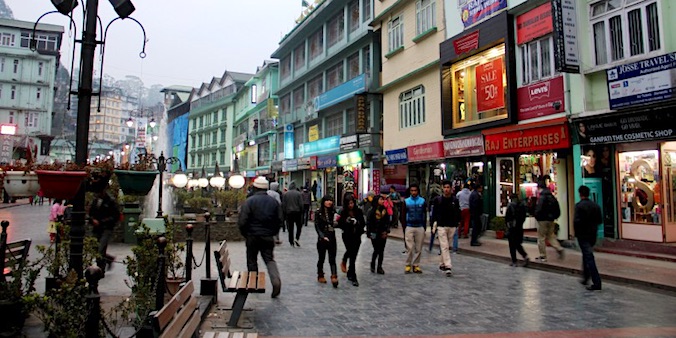
Gangtok
In Sikkim’s capital Gangtok, the rear neighbours almost always live on another street and hardly anyone has a garden, because the slopes are too steep for that. This also means that the roads are nowhere wide and often clogged. But fortunately most locations in the city can be reached on foot. Pedestrians can use a whole series of footbridges to cross busy roads. Gangtok was also the first city in India to declare its centre a pedestrian area. Here it is pleasant to stroll and shop and there are numerous ‘hip’ restaurants and cafes. Thanks to the government’s serious approach to environmental problems – a rarity in India – this is also one of India’s cleanest city centres. Interesting places to visit include the flower exhibition – with many varieties of orchids, – the Institute of Tibetology, Enchey Gompa and Tashi Viewpoint.
